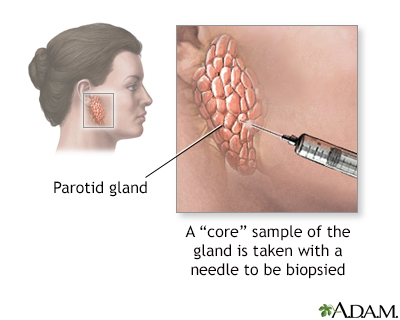Pregnancy SmartSiteTM
Biopsy - salivary gland DefinitionSalivary gland biopsy is the removal of cells or a piece of tissue from a salivary gland for exam. How the Test is PerformedYou have several pairs of salivary glands that drain into your mouth:
One type of salivary gland biopsy is a needle biopsy.
A biopsy can also be done to:
An open surgical biopsy of the minor salivary glands in the lips or the parotid gland can also be performed to diagnose diseases such as Sjögren syndrome. How to Prepare for the TestThere is no special preparation for a needle biopsy. However, you may be asked not to drink or eat anything for a few hours before the test. For surgical removal of a tumor, preparation is the same as for any major surgery. You will not be able to eat anything for 6 to 8 hours before the surgery. How the Test will FeelWith a needle biopsy, you may feel some stinging or burning if a local numbing medicine is injected. You may feel pressure or mild discomfort when the needle is inserted. This should only last for 1 or 2 minutes. The area may feel tender or be bruised for a few days after the biopsy. The biopsy for Sjögren syndrome requires an injection of the anesthetic in the lip or in the front of the ear. You will have stitches where the tissue sample was removed. Why the Test is PerformedThis test is done to find the cause of abnormal lumps or growths of the salivary glands. It is also done to diagnose Sjögren syndrome. Normal ResultsThe salivary gland tissue is normal. What Abnormal Results MeanAbnormal results may indicate:
RisksRisks from this procedure include:
ReferencesMiloro M, Kolokythas A. Diagnosis and management of salivary gland disorders. In: Hupp JR, Ellis E, Tucker MR, eds. Contemporary Oral and Maxillofacial Surgery. 7th ed. Philadelphia, PA: Elsevier; 2019:chap 21. Orlowski HLP, Miller-Thomas M. Diagnostic imaging and fine-needle aspiration of the salivary glands. In: Flint PW, Francis HW, Haughey BH, et al, eds. Cummings Otolaryngology: Head and Neck Surgery. 7th ed. Philadelphia, PA: Elsevier; 2021:chap 82. | |
| |
Review Date: 3/1/2023 Reviewed By: Josef Shargorodsky, MD, MPH, Johns Hopkins University School of Medicine, Baltimore, MD. Also reviewed by David C. Dugdale, MD, Medical Director, Brenda Conaway, Editorial Director, and the A.D.A.M. Editorial team. The information provided herein should not be used during any medical emergency or for the diagnosis or treatment of any medical condition. A licensed medical professional should be consulted for diagnosis and treatment of any and all medical conditions. Links to other sites are provided for information only -- they do not constitute endorsements of those other sites. No warranty of any kind, either expressed or implied, is made as to the accuracy, reliability, timeliness, or correctness of any translations made by a third-party service of the information provided herein into any other language. © 1997- A.D.A.M., a business unit of Ebix, Inc. Any duplication or distribution of the information contained herein is strictly prohibited. | |

 Salivary gland bio...
Salivary gland bio...
